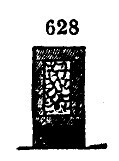2132. The best mode, however, of heating the atmosphere of conservatories, hothouses, &c., by steam, is when it is discharged into cases of masonry or brickwork. Figs. 628. and 629. represent a mode of heating, by introducing steam into cases of stone or brickwork, filled with rubble-stones or pieces of broken brick. This mode is equally applicable to the largest or smallest establishments. The agent being steam, it possesses the same facility of application as steam applied to hot-water pipes, and consequently the same advantages, and may be adopted in conjunction with hot-water pipes or not, as may be thought desirable. Fig. 628. represents a cross section of a case of masonry or brickwork, suitable for a greenhouse of 14 ft. wide, with a glazed roof, and 2 ft. 6 in. of glass in front. Fig. 629. shows a view of the same, with a part of the front taken away at each end to show the inside. The steam-pipes are placed about 4 in. above the bottom, and have perforations of about one tenth of an inch in diameter; which vary from 15 in. to 18 in, asunder throughout their whole length, but become more frequent at the farther end, which is closed. The general direction of the holes is upwards, except some few in the bottom, to keep the pipe clear of condensed water. The case being built inclining towards the most convenient spot for draining, the condensed water is taken away by a small siphon, about 3 or 4 in. deep, as shown in fig. 629. A steam-pipe of 1 in. diameter is sufficient for a case of 50 ft. in length; and, if proper attention be paid to the dimensions and distance of the holes, which in this case need not be above one sixth closer at the farther end than at the commencement, scarcely the least difference of temperature will be perceptible at each end of the case; an effect utterly unattainable in the best constructed fire-flue, which, in appearance, it so much resembles. There is, however, no particular proportion of the height to the breadth; that depending entirely on convenience. Where freestone cases are used, it is found necessary that they should receive two or three coats of linseed oil, to prevent the escape of steam through them. It is better to give moisture to the house by steam-cocks fixed at the top of the cases, as shown in fig. 629.; humidity can then be regulated at pleasure.



